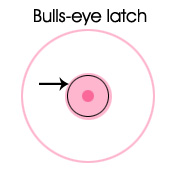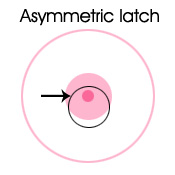
If you are a mom that is struggling to get your baby to latch on, you may be feeling frustrated, emotional, and defeated. Breastfeeding is supposed to be a natural process, and yet your baby just can’t get it figured out. When you look for advice, you may find that the instructions for latching on are so complicated and contain so many details that you just can’t keep it all straight. Moreover, the information you may have been given on how to latch, even from the professionals, may not be working for you. If you’ve tried getting your baby to latch and she just won’t do it, we are here to help with easy advice on how to get your baby to latch. Take a deep breath and read on.
Before You Sit Down to Nurse
Watch for hunger cues: Before you try to sit down and nurse your baby, it’s important to make sure you are relaxed and that your baby is not too hungry and frustrated. Watch her for hunger cues. When she’s starting to get hungry, she may suck on her fingers or hands, smack or lick her lips, root around, squirm, or fuss. If she starts frantically sucking on her fingers or crying, these are later hunger cues. If you wait until she’s very hungry and frustrated, latching on will be more difficult, especially if she’s already gotten accustomed to the instant gratification that goes along with bottle feeding. Try to offer her the breast when she first shows signs of being hungry.
Pick a comfortable position: Find a position that is comfortable for you. You may want to use a nursing pillow to help you get comfortable. One of the easiest positions for beginners is the cradle hold. If you are using a nursing pillow, you may find a variation of the cradle hold called the cross-cradle hold, works best. See LLLI’s How do I position my baby to breastfeed?
Once you’re comfortable you can try latching on. Here are a few of the most common techniques for latching on. You may want to try more than one method to see which feels right and works best for you.

Most Common Techniques for Latching On
 Bulls-eye latch: This is one of the oldest methods for latching on. This is most likely the technique you were taught in the hospital. This technique works best with the cradle hold. With this method, you hold your breast with your free hand and tickle your baby’s lip with your nipple. When your baby feels your nipple on her mouth, she will open up her mouth instinctively. Wait until she opens her mouth wide and then attempt latching on.
Bulls-eye latch: This is one of the oldest methods for latching on. This is most likely the technique you were taught in the hospital. This technique works best with the cradle hold. With this method, you hold your breast with your free hand and tickle your baby’s lip with your nipple. When your baby feels your nipple on her mouth, she will open up her mouth instinctively. Wait until she opens her mouth wide and then attempt latching on.
When her mouth is opened wide, position your nipple towards the center of her mouth and quickly pull her in towards you using the arm that is supporting her head. You want to get as much of the areola into her mouth as possible. Make sure she gets plenty of areola in her mouth. She will not be able to remove as much milk from your breast if she is only sucking on the nipple. And, this type of shallow latch often results in nipple soreness.
Helpful link:
Proper Positioning and Latch-on Skills
 Asymmetric latch: The asymmetric latch is similar to the bulls-eye latch, but instead of trying to get baby centered onto the nipple, baby is latched slightly off-centered. With this method, baby gets more breast tissue close to her lower jaw and tongue. If you look at the diagram, you will see that instead of getting some areola tissue above the nipple and some areola tissue below the nipple, she is getting a lot more of the breast tissue below the nipple in contact with her lower jaw. By having more tissue contacting your baby’s tongue and lower jaw, baby is better able to remove milk. This latch may also feel more comfortable for mom.
Asymmetric latch: The asymmetric latch is similar to the bulls-eye latch, but instead of trying to get baby centered onto the nipple, baby is latched slightly off-centered. With this method, baby gets more breast tissue close to her lower jaw and tongue. If you look at the diagram, you will see that instead of getting some areola tissue above the nipple and some areola tissue below the nipple, she is getting a lot more of the breast tissue below the nipple in contact with her lower jaw. By having more tissue contacting your baby’s tongue and lower jaw, baby is better able to remove milk. This latch may also feel more comfortable for mom.
It’s easiest to use the cross-cradle hold when using the asymmetric latch. Tickle your baby’s lip with your nipple, like you would with the bulls-eye latch, and wait for her to open wide. When she opens wide, aim her mouth just below your nipple, so that her lower lip and chin are lined up a little below your nipple. Your goal is for her to connect with your areola first and then the nipple. When she gets the areola into her mouth, quickly bring her mouth over the nipple so that she has both the areola and the nipple in her mouth.
Helpful links:
Asymmetric latch videos
Asymmetrical latch photo tutorial
Nipple Sandwich technique: To help your baby get more of the breast tissue into her mouth you can try the nipple sandwich technique. When your baby tries to latch onto your breast, she may have a hard time getting enough tissue in her mouth. If you think of your breast like a thick submarine sandwich, it’s easy to understand why. When you hold onto a sandwich to take a bite, what do you do? You squish it so the bread fits into your mouth. You don’t just try to bite into it. This is the rationale of the nipple sandwich technique. Think about the position of your baby’s mouth when she “takes a bite” of the nipple sandwich. You want your breast to be compressed (vertically if she’s lying across your lap or horizontally if you’re using the football hold) so that when she latches on, she doesn’t have to work so hard to get it all in her mouth.
Helpful links:
Positioning and nipple sandwich technique with pictures
Nipple Sandwich with a twist
Deep latch technique
Flipple technique: If you have a hard time getting your baby to open her mouth wide or just can’t get your nipple into her mouth using the traditional techniques, you may want to try the flipple technique. It’s a variation of the asymmetric latch. Here’s how you do it. First place your finger above your nipple and press into your breast. This will flip your nipple upward. Then position your baby below your nipple. As soon as she opens her mouth wide, use your finger to flip the nipple into her mouth. Once she is latched on, remove your finger.
Helpful links:
Flipple technique
Flipple technique video
Nipple twist latch (a variation of the flipple technique)
More latching technique links:
Positioning: A New Perspective
Baby-led latch: If you are trying to get baby to latch on and are having a difficult time with all of the techniques, you may want to read more about the concept of baby-led latching. Pediatrician Christina Smillie discussed this idea with Today’s Parent magazine. Dr. Smillie believes that babies were born with instincts that guide them on how to find their mother’s nipple and latch on. Sometimes by trying to get your baby to latch a certain way, you can get in her way and keep her from figuring things out all on her own.
To try baby-led latching, just relax and cuddle with your baby skin to skin. Sit in a comfortable chair with baby in an upright position. Let baby naturally find her way to your breast when she gets hungry. You can help baby to get closer to your breast, but try to let baby make the moves. When she gets close to your breast and starts rooting, let her find your nipple and latch on.

How Can You Tell if Your Baby Is Latched On Correctly?
Here are a few signs of a good latch:
- You should not have pain. You may feel some discomfort when baby first latches on, however. This should only last for a few seconds and should go away once your baby has been breastfeeding for a week or so. If you have pain or nipple soreness, this is likely due to incorrect latching and positioning.
- Your baby’s lips should be flanged (or turned outward like a fish).
- Your baby should have at least 1 inch of your areola in her mouth.
- You should see baby’s ears wiggle when he swallows.
- You should hear baby swallowing.
- You should see and feel a good seal. Milk shouldn’t leak out the sides if your baby is latched on well.
If You Are Still Having Problems with Latching On:
If you have tried all of the techniques listed and are still having problems, either with refusal to latch or painful latch, you may want to work with a lactation consultant. You can also get help from a breastfeeding peer counselor or the La Leche League.
Resources:
La Leche League
National Breastfeeding Helpline
Find a Lactation Consultant
